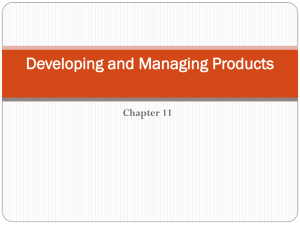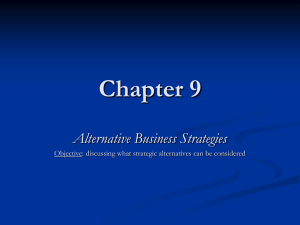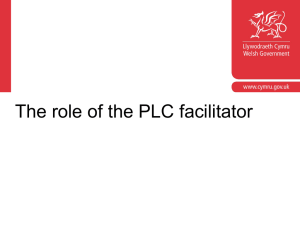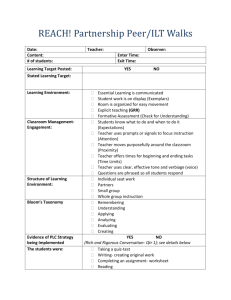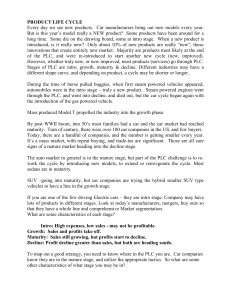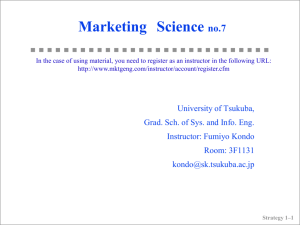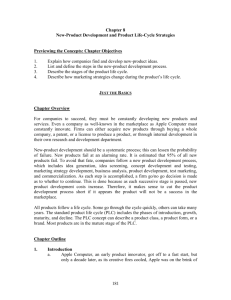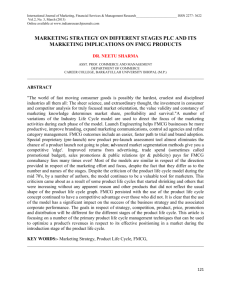Chapter 8: New-Product Development and Product
advertisement
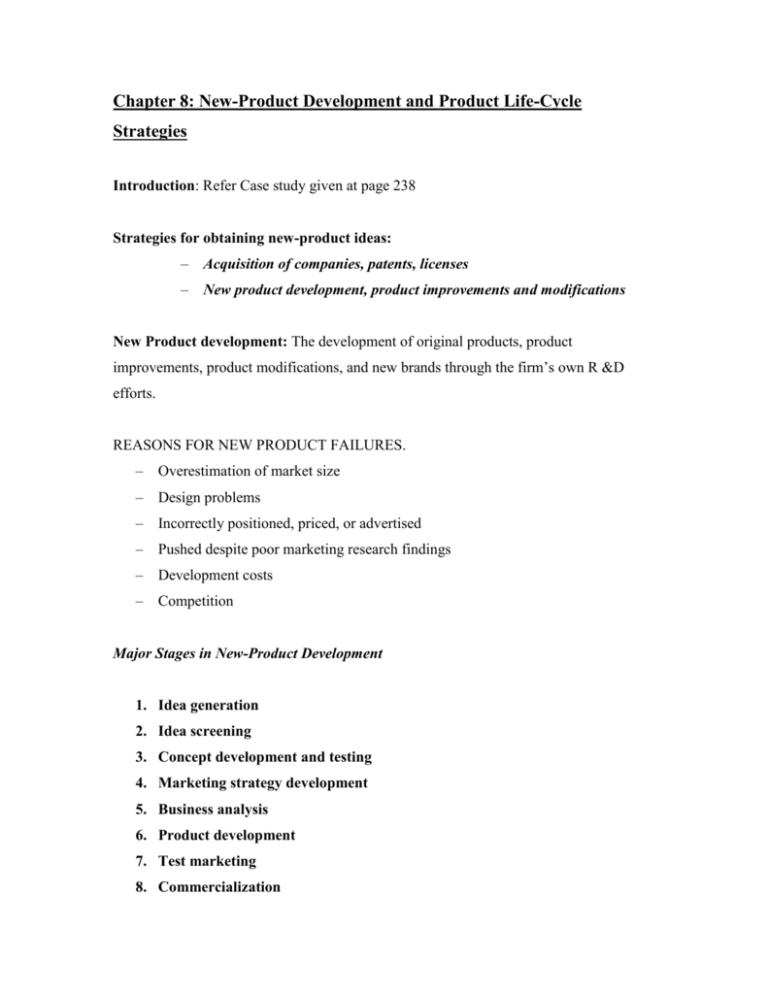
Chapter 8: New-Product Development and Product Life-Cycle Strategies Introduction: Refer Case study given at page 238 Strategies for obtaining new-product ideas: – Acquisition of companies, patents, licenses – New product development, product improvements and modifications New Product development: The development of original products, product improvements, product modifications, and new brands through the firm’s own R &D efforts. REASONS FOR NEW PRODUCT FAILURES. – Overestimation of market size – Design problems – Incorrectly positioned, priced, or advertised – Pushed despite poor marketing research findings – Development costs – Competition Major Stages in New-Product Development 1. Idea generation 2. Idea screening 3. Concept development and testing 4. Marketing strategy development 5. Business analysis 6. Product development 7. Test marketing 8. Commercialization IDEA GENERATION New product development starts with Idea generation-The systematic search for new product ideas. A company typically has to generate many ideas in order to find a few good ones. For example, one brainstorming session for Prudential insurance company came up with 1500 ideas and only 12 were considered even usable. Major sources for new ideas include Internal sources and external sources such as customers, competitors, distributors, and suppliers, and others. INTERNAL IDEA SOURCES Internal sources include company employees at all levels. Companies can pick the brains of its executives, scientists, engineers, manufacturing staff, and sales people. EXTERNAL IDEA SOURCES – Customers Good new product ideas also come from watching and listening to customers. Company engineers or sales people can meet with and work alongside to get suggestions and ideas. – Competitors Companies watch competitor’s adds to get clues about their new products. They buying competing new products, take them apart to see how they work, analyze their sales, and decide whether they should bring out a new product of their own. – Distributors & Suppliers Distributors and suppliers can also contribute many good and new product ideas. Resellers are those close to the market and can pass along information about customer problems and new product possibilities. Suppliers can tell company about new concepts, techniques, and materials that can be used to develop new products. – Outsourcing Many companies are now outsourcing some of their new product innovation to outside developers. Companies such as Dell, Motorola sometimes buy new designs from Asian developers and then market under their own brand names. Other idea sources include Trade magazines, shows, seminars, government agencies, new product consultants, advertising agencies, marketing research firms, university and commercial laboratories, and inventors. IDEA SCREENING: Process used to spot good ideas and drop poor ones. The purpose of idea generation is to create a large number of ideas. The purpose of the succeeding stages is to reduce that number. The first idea reducing stage is the Idea screening. – Executives provide a description of the product along with estimates of market size, product price, development time and costs, manufacturing costs, and rate of return. – Evaluated against a set of company criteria for new products. For example, at Kao company, the large Japanese consumer products company, the new product committee asks questions such as “Is the product truly useful to the consumers and society?”, “Do we have the people, skills, resources, to make it proceed?” etc. CONCEPT DEVELOPMENT AND TESTING An attractive idea must be developed into a product concept. It is important to distinguish between product idea, product concept, and a product image. Product Idea: – Product Concept: – idea for a possible product that the company can see itself offering. detailed version of the idea stated in meaningful consumer terms. Product Image: – the way consumers perceive an actual or potential product. For example, after more than 10 years of development, Daimler Chrysler is getting ready to commercialize its experimental cell powered electric car into the market. This car’s non polluting fuel system runs directly on Hydrogen. Daimler Chrysler is currently testing more than 100 F cell cars under varying weather conditions, traffic situations, and driving styles in world wide. Now Daimler’s task is to develop this into alternative product concept, find out each how attractive each concept to its customers, and choose the best one. Concept one: A moderately priced sub compact designed as a second family car to be used around town. Concept two: A medium cost sporty compact appealing to the young people. Concept three: An inexpensive subcompact green car appealing to environmentally conscious people. CONCEPT TESTING: Testing the new product concepts with a group of target consumers to find out if the concepts have strong consumer appeal is called concept testing. After being exposed to the concept, consumers then may be asked to react to it by answering questions such as those in table 8.1 MARKETING STRATEGY DEVELOPMENT The next step is marketing strategy development which is designing an initial marketing strategy for a new product based on the product concept. The marketing strategy statement consists of three parts. Part One: – Describes the target market, planned product positions, sales, market share, and profit goals. Part Two: – Outlines the product’s planned price, distribution, and marketing budget. Part Three: – Describes the long-run sales and profit goals, marketing mix strategy. BUSINESS ANALYSIS Involves a review of the sales, costs, and profit projections to assess fit with company objectives. If results are positive, project moves to the product development phase. PRODUCT DEVELOPMENT Product development involves developing the product concept into physical product in order to ensure that the product idea can be turned into a workable product. Calls for large jump in investment. Prototypes are made. Prototype must have correct physical features and convey psychological characteristics Eg: Gillette uses employee volunteers to test new shaving products. Every working day at Gillette, 200 volunteers from various departments come to work unshaven. The volunteers are given razors, shaving cream or after shave to use. The volunteers evaluate razors for sharpness of blade, smoothness of glide, ease of handling. In a nearby shower room, woman performs the same ritual on their legs, underarms, and what the company delicately refers to as “Bikini area”. TEST MARKETING If the product passes functional and a consumer test, the next step is Test marketing, the stages of product development in which the product and marketing program are tested in more realistic market settings. Product and program introduced in more realistic market setting. Not needed for all products. Can be expensive and time consuming, but better than making major marketing mistake. COMMERCIALIZATION Test marketing gives the management the information needed to make final decision about whether to .launch a new product. Commercialization means introducing the new product into the market. The company may have to build or rent a manufacturing facility. It may have to spend, in the case of a new consumer-packaged good, between $10 million and $200 million for advertising, sales promotion, and other marketing efforts in the first year. The company launching of a new product Must decide on timing (i.e., when to introduce the product). Must decide on where to introduce the product (e.g., single location, state, region, nationally, internationally). Must develop a market rollout plan. THE PRODUCT LIFE CYCLE (PLC) After launching the new product, management wants the product to enjoy a long and happy life. Although the company doesn’t expect its product to sell forever, the company wants to earn a decent profit to cover all the effort and risk that went into launching it. . Product Life Cycle (PLC) is the course of a products sales and profits over its lifetime. It involves five distinct stages: product development, introduction, growth, maturity and decline. Figure given below shows a typical product life cycle (PLC) although its exact length and shape is not known in advance Practical Problems of PLC Hard to identify which stage of the PLC the product is in. Hard to pinpoint when the product moves to the next stage. Hard to identify factors that affect product’s movement through stages. Hard to forecast sales level, length of each stage, and shape of PLC. Strategy is both a cause and result of the PLC. Introduction Stage of PLC The introduction stage starts when the new product is first launched. Introduction takes time, and sales growth is apt to be slow. Products such as Instant coffee, frozen foods etc lingered for many years before they entered a stage of rapid growth. In this stage, as compared to the others, profits are negative or low because of the low sales and high distribution and promotion expenses. Much money is needed to attract distributors and build their own inventories. Promotion spending is relatively high to inform consumers of the new product and get them to try it. Growth Stage of PLC If the new product satisfies the market, it will enter a new growth stage in which sales will start climbing quickly. The early adopters will continue to buy and later buyers will start following their lead, especially if they hear favorable word of mouth. Attracted by the opportunities for profit, new competitors will enter the market. They will introduce new product features, and the market will expand. The increase in competitors will lead to increase in the number of distribution outlets, sales jump just to build reseller inventories. Prices remain same or fall only slightly. Companies keep their promotion spending at the same or a slightly higher level. Profits increase during the growth stage, as promotion expenses are spread over a large volume and as unit manufacturing costs fall. The firm uses several strategies to sustain rapid market growth rate as long as possible. Maturity Stage of PLC At this stage of PLC, product sales growth will slow down. The maturity stage normally lasts longer than the previous stages and poses strong challenges to marketing management. In any market, most products are in the maturity stages of the life cycle. Therefore, most of the marketing management deals with mature product. Competitors begin marking down prices, increasing their advertising and sales promotion and allocate their R&D budgets to find better versions of the product. These steps lead to a drop in profit. Some of the weaker competitors start dropping out, and the industry eventually contains only well established competitors. Decline Stage of PLC The sales of most product forms and brands eventually dip. The decline may be slow or rapid depends on the products. Sales may plunge to zero or they may drop to a level where they continue for many years. This stage is the decline stage. As sales and profits decline, some firms withdraw from the market. Carrying a weak product can be very costly to the firm, and not just in profit terms. A weak product often requires frequent price and inventory adjustments. A products falling reputation can cause customers concern about the company and its products. For these reasons, companies need to pay more attention to their aging products. The firm’s first task is to identify those products in the decline stage by regularly reviewing sales, market shares, costs and profit trends.


